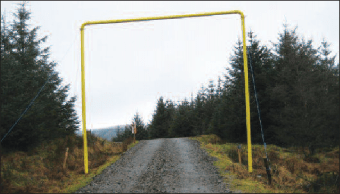Are you certain of the location of all utility services on your site? This is a question we must all ask when on site.
- The presence of some utilities is obvious, such as Overhead Powerlines (OHPL), however, some are less obvious, typically those buried beneath the surface.
To work safely where utility services run through our sites, we must make suitable enquiries with the landowner and the owners of the utilities. However, it isn’t enough to just assume an absence of utilities or their position. If you are unsure, or work on site changes, then you must stop work and review the situation.
This is the action taken recently by several Tilhill staff and contractors. A Landscaping team had been provided with electrical cable drawings but verified the location and scanned the work area. In doing so the scanner picked up an unexpected signal. The Network Operator could not confirm what the signal was from but assumed it was an inducted signal in an old cable that had been previously rerouted. The team insisted that the Network Operator come out to site to prove the cable was indeed disconnected and not live. Proving the cable was safe was the correct course of action.
In another example of good practice, a harvesting team began extraction from a site across third party land. After just a few loads it was identified that the extraction route crossed an intermediate gas pipeline. Extraction was stopped immediately. The extraction route had changed part way through planning after advice had originally been sought from the Network Operator. The pipeline had been mapped as far as the original extraction route required it. It had been assumed that the line would continue to run away from the site but, had the pipeline been reviewed when extraction plans were changed this would have shown the pipeline actually changed direction through 90 degrees. Stopping as soon as it was discovered that the Hazards and Constraints map was not complete was the correct course of action.
On another harvesting site the team was unable to move timber while awaiting information regarding suitable heights for goal posts from the Network Operator. This is normally a simple process where the Network Operator comes to site, measures the height of the lines and provides the GS6 form with the relevant details. On this occasion, the GS6 form was not provided. The harvesting team was not prepared to assume the correct height and sought assistance from the Safety & Assurance Team. Not making an assumption and asking for help was the correct course of action.
The striking of utilities with machinery is a known killer. We must never assume the safety surrounding them. We must verify their location and the required control measures to keep all on site safe. Everyone working for Tilhill has the right to stop work if they feel it presents a danger to life. We have recently updated our Health & Safety Policy to reflect this. We Insist that this right is exercised so we can find safe and healthy ways to work. Stopping can be Starting – Starting to work safely.
FISA 804 contains more details on how to work safely with electricity in Forestry http://www.ukfisa.com/Safety/Safety-Guides/fisa-804



